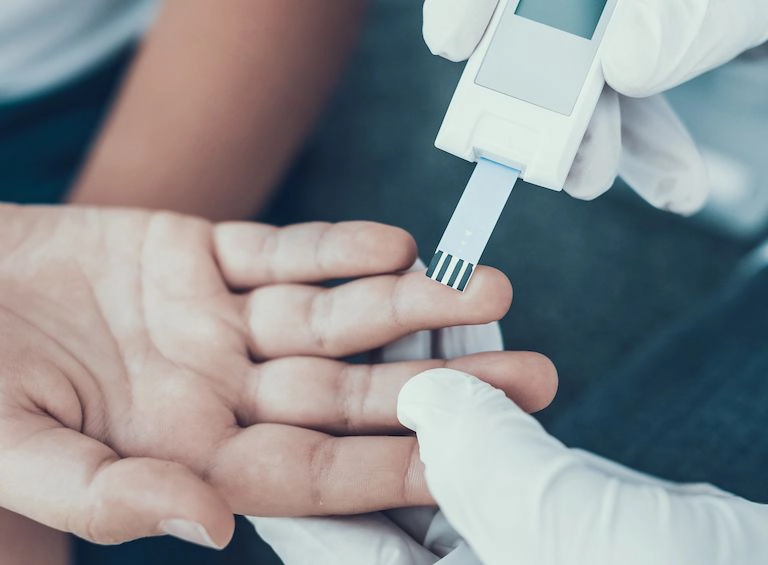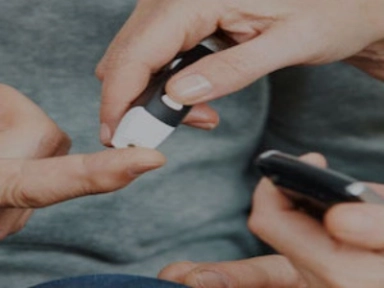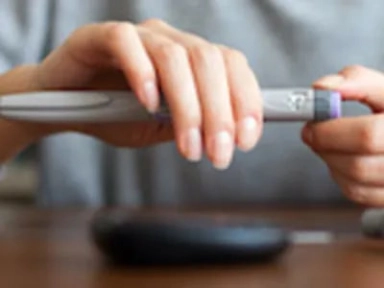Hospitalization Rates for Acute Diabetes Complications Before and After Flash Glucose Monitoring Initiation Among People with Type 1 or Type 2 Diabetes in France: The Relief Study
This large retrospective study revealed that access to flash glucose monitoring (FGM, supported by FreeStyle Libre system) resulted in a subsequent drop-in rate of hospitalizations for diabetic ketoacidosis (DKA) and diabetes-related coma.
Main takeaway
-
This large study using health episode statistics of people with diabetes from a nationwide database quantified the correlation between FGM intervention and the incidence of hospitalization for acute diabetes complications in France for both type 1 diabetes (TID) and type 2 diabetes (T2D).
-
Hospitalization rates for acute diabetes complications decreased by 45.7% in the year following FreeStyle Libre initiation.
-
Decrease in hospitalization for acute diabetes complications following FreeStyle Libre initiation: −49.0% vs −39.4% for T1D vs T2D
-
Reductions in hospitalizations were notable for DKA and diabetes-related comas but were also found for hypoglycemia and hyperglycemia.
-
-
This analysis has important implications for patient-centered clinical care in diabetes and helps further investigation of the long-term health economic benefits at a national level.
Why this matters
-
Hospitalizations for acute diabetes complications are increasing and are associated with significant healthcare use and cost, although these healthcare emergencies can be prevented by frequent glucose monitoring.
-
The influence of the novel glucose-sensing technology on hypoglycemia was evaluated in a randomized controlled study; however, its efficacy in acute diabetes complications still needs to be evaluated.
Study design
-
This longitudinal retrospective cohort study (RELIEF) used data from the national French database Systeme National des Donnees de Sante (SNDS) between January 1, 2015, and December 31, 2018.
-
Only individuals with diabetes who newly initiated the FreeStyle Libre system between August 1, 2017, and December 31, 2017, were included and were evaluated for 12 months before and after initiating the FreeStyle Libre system.
-
An algorithm was used to identify any patient who used the FreeStyle Libre system as having diabetes only if they had received ≥3 reimbursements for antidiabetic drugs (oral or insulin) over 1 year or within the 2 years preceding or 1 year after FreeStyle Libre initiation (or at least two reimbursements if one large pack size was dispensed) or if the patient was hospitalized (as per ICD-10 code) at least once with T1D, T2D, or unspecified diabetes.
-
Exclusion criteria: Only one FreeStyle Libre reader reimbursement without any further reimbursements for sensors; deceased before the first sensor reimbursement; <18 years old without insulin therapy for 6 months before and after FreeStyle Libre initiation
-
Hospitalizations for DKA, severe hypoglycemia, diabetes-related coma, and hyperglycemia were estimated for the 12 months before and after FreeStyle Libre initiation.
-
Persistence with the FreeStyle Libre system was also evaluated (defined between first delivery of a FreeStyle Libre sensor and its discontinuation).
Key results
-
Overall, 74,011 individuals with diabetes (T1D: n = 33,165; T2D: n = 40,846) were identified with first reimbursement for FreeStyle Libre sensors between August 1, 2017, and December 31, 2017.
-
Among the included individuals, 88% were treated with multiple daily injections of insulin (n = 46,828) or continuous subcutaneous insulin infusion (n = 18,593), and the remaining 12% (mainly T2D) were treated with a single basal insulin injection or with oral agents only.
-
Significant reduction in the percentage of patients with at least one acute diabetes complication (45.7% [T1D, 49.0%; T2D, 39.4%]) was found in the year after starting FreeStyle Libre compared with the year before.
-
Hospitalization rates decreased more markedly for DKA than for other acute complications in both types of diabetes
-
DKA: Reduced by 55.0% (T1D, −56.2%; T2D, −52.1%)
-
Diabetes-related coma: Reduced by 35.7% (T1D, −39.6%; T2D, −31.9%)
-
Hypoglycemia: Reduced by 6.4% (decreased mainly for T2D, −10.8%)
-
Hyperglycemia: Reduced by 13% (decreased mainly for T2D, −26.5%)
-
-
Following FreeStyle Libre initiation, hospitalizations decreased by 54.0% and 51.2% in people noncompliant (no consumption of test strips) with self-monitoring of blood glucose (SMBG) and in those with the highest acquisition of SMBG (>5 strips), respectively.
-
Persistence with the FreeStyle Libre at 12 months after initiation was 98.1% (95% confidence interval [CI]: 98.0–98.2) across all users.
Limitations
-
The study lacked a control group.
-
The study could not exclude DKA at diagnosis, which may have occurred during the 12 months before initiation.
-
In the request for data submitted to SNDS, other real-time continuous glucose monitoring systems could not be included.
-
Clinical or biological data, such as HbA1c measurements, were lacking.
-
Outcomes accuracy relies on the quality of coding, which was not assessable in the study.
- Roussel R, Riveline JP, Vicaut E, de Pouvourville G, Detournay B, Emery C, et al. Important drop rate of acute diabetes complications in people with type 1 or type 2 diabetes after initiation of flash glucose monitoring in France: The RELIEF Study. Diabetes Care. 2021:dc201690. doi: 10.2337/dc20-1690. Epub ahead of print. PMID: 33879536.




